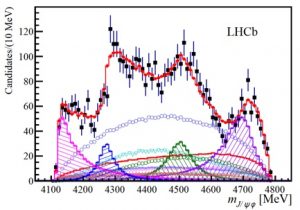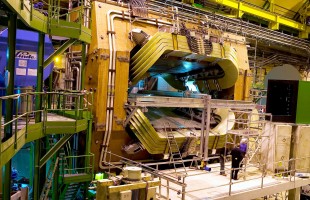On 28 June, the LHCb collaboration reported the observation of three new “exotic” particles and the confirmation of the existence of a fourth one in data from the Large Hadron Collider (LHC).

These particles seem to be formed by four quarks (the fundamental constituent of the matter inside all the atoms of the universe): two quarks and two antiquarks (hence, a tetraquark).
The quark model, proposed in 1964 by Murray Gell-Mann and George Zweig, is the most valid classification scheme of hadrons (all the composite particles) that has been found so far and is part of the Standard Model of particle physics. In this model, hadrons are classified according to their quark content. They also included the possibility of “exotic” hadrons, such as mesons containing two quarks and two antiquarks (tetraquarks), or four quarks and an antiquark (pentaquarks). There is no clear reason why such exotic combinations of quarks should not exist. However, such particles were only discovered during the last decade, and – for yet unknown reasons – they all contain a charm and an anticharm quark. For example, in 2009 the CDF collaboration found one of these, called X(4140) – where the number in parentheses is its reconstructed mass in megaelectron volts. This result was then confirmed later by a new CDF analysis, and by the CMS and D0 collaborations, while the Babar, Belle and LHCb experiments did not observe this particle.
In a new analysis of LHC data recorded in 2011 and 2012, LHCb could confirm the existence of the X(4140) particle and determine its properties. This result has a large impact on the possible theoretical interpretations, and indeed it excludes some of the previously proposed theories on its nature. The same analysis also reported the observation of yet unknown particles of the same kind, called X(4274), X(4500) and X(4700). Even though the four particles all contain the same quark composition, they each have a unique internal structure and mass.
These results are based on a detailed analysis of the decay of a B+ meson into mesons called J/ψ, φ and K+, where the new particles appear as intermediate ones decaying to a pair of J/ψ and φ mesons. The large signal yield efficiently collected with the LHCb detector has allowed LHCb scientists to discover those three new particles that were (literally, see the picture) peaking out from the data.
This news comes in addition to the discovery of the first two pentaquark particles by the LHCb collaboration last year.
“At LHCb we are primarily searching for the origin of the matter-antimatter asymmetry observed in the Universe”, says Nikhef-physicist Patrick Koppenburg, former physics coordinator of the LHCb experiment. “This can be achieved by studying in great detail decays of B mesons, as that used in this analysis. While doing this we stumbled over unexpected exotic hadrons. They found us more than we found them.”

More information
More information about the tetraquark results on the LHCb website and in the two submitted scientific papers (see here (link is external) and here (link is external)).
